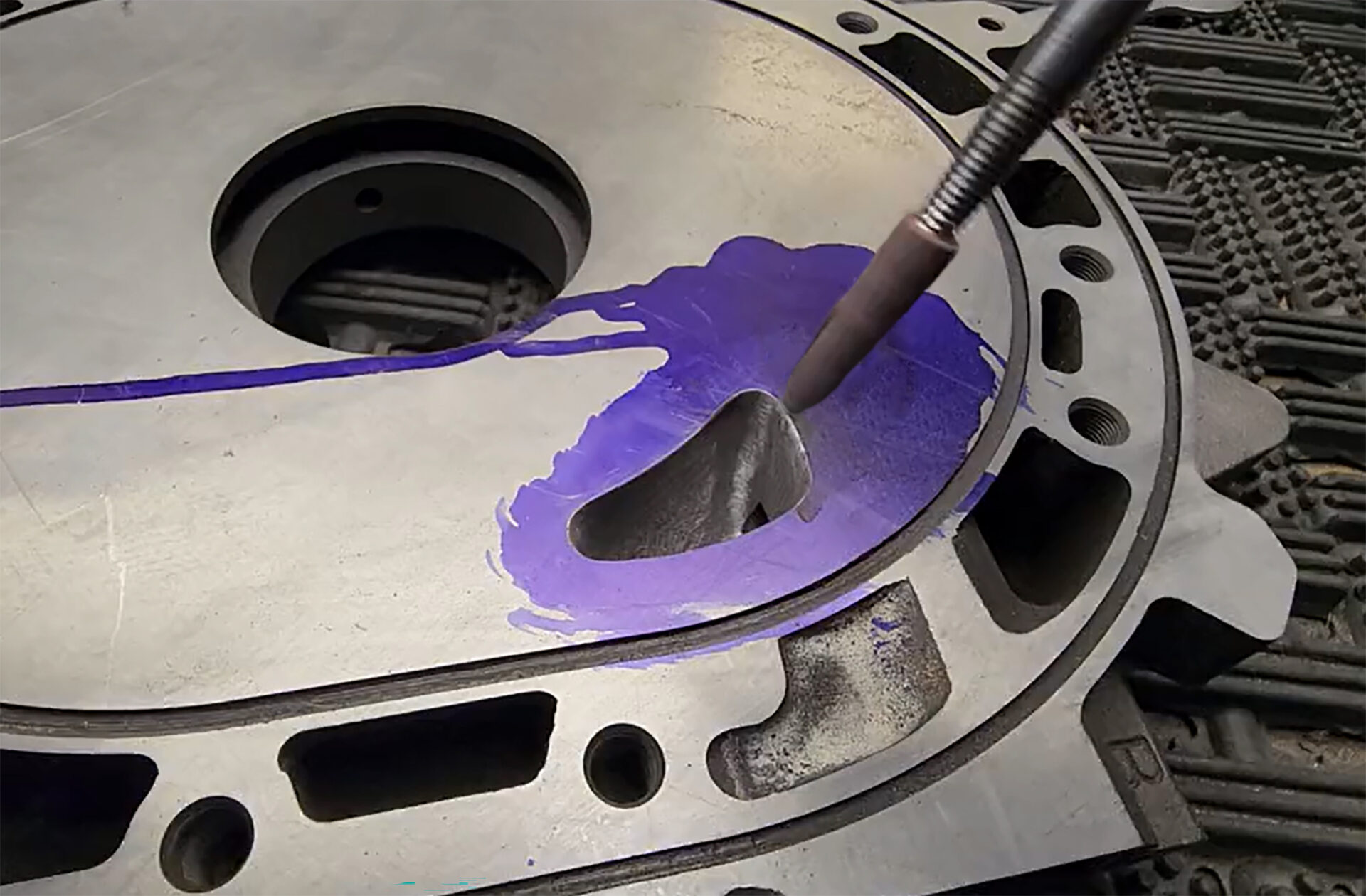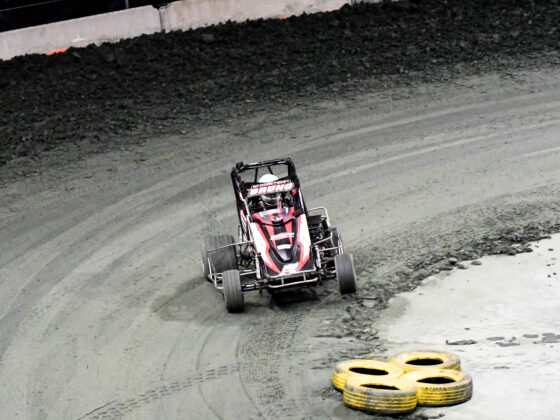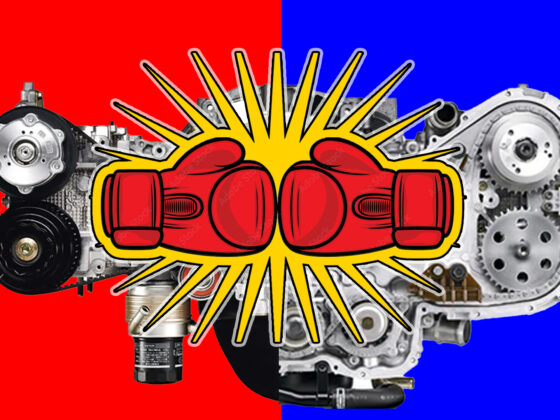 Now that the dowel holes and Semi Peripheral port sleeves were machined into the housing, the water jacket needs to be filled.
Now that the dowel holes and Semi Peripheral port sleeves were machined into the housing, the water jacket needs to be filled.
 This pocket can be filled with Devcon 10720, JB Weld, or any kind of metallic epoxy. Our engine builder Abel Ibarra prefers JB Weld and has had success using it for decades.
This pocket can be filled with Devcon 10720, JB Weld, or any kind of metallic epoxy. Our engine builder Abel Ibarra prefers JB Weld and has had success using it for decades.
 With all the porting and machine work done to our irons and housings, we sent them off to CTP Cryogenics to be thermally treated and then WPC for their Metal Surface Treatment. We talked about these two processes in Part 12 – Rotor Lightening, WPC and Cryo where we used this combination on our lightened rotors, apex seals, side seals, and e-shaft. Now we are applying the same treatments to the irons and housings of our 13B REW.
With all the porting and machine work done to our irons and housings, we sent them off to CTP Cryogenics to be thermally treated and then WPC for their Metal Surface Treatment. We talked about these two processes in Part 12 – Rotor Lightening, WPC and Cryo where we used this combination on our lightened rotors, apex seals, side seals, and e-shaft. Now we are applying the same treatments to the irons and housings of our 13B REW.
According to Abel and other rotary engine builders, as power increases, the irons and housings start to shift, distort, and flex. This is seen though witness marks and ovaling of the housings around the dowels and is the main cause of rotor to iron contact, not from the rotor ‘wobbling’ excessively on the e-shaft. Due to the stackable nature of the rotary engine block, increasing rigidity with more dowels is crucial to maintain the tolerances of the block and preventing rotor to iron contact.
CTP Cyrogenic’s thermal treatment of the irons and housings of a rotary engine will improve the grain structure in the metal to not only reduce the internal stresses within the metal, but will increase the strength and stiffness of the engine block. This is the biggest benefit that we are looking for when treating the block itself and combined with the added doweling, our block should be substantially more rigid and stable under extreme load.
 WPC Treatment is not a coating but a metal surface finishing process that improves the surface hardness, ‘normalizes’ the surface’s peaks and valleys, and creates micro-dimples that retain oil molecules. All of this helps to reduce friction and increases durability in parts. We treated the iron faces to improve the seal and reduce heat and friction caused by the side and corner seals.
WPC Treatment is not a coating but a metal surface finishing process that improves the surface hardness, ‘normalizes’ the surface’s peaks and valleys, and creates micro-dimples that retain oil molecules. All of this helps to reduce friction and increases durability in parts. We treated the iron faces to improve the seal and reduce heat and friction caused by the side and corner seals.
 We also treated the inner rotor housings to improve the performance and longevity of our apex seals, which will now smoothly operate and slide within the rotor as it traverses the trichoid since the rotors and apex seals are WPC treated. This process has improved the durability of apex seals in the FD RX-7s that raced in the Super GT category in Japan for many race seasons.
We also treated the inner rotor housings to improve the performance and longevity of our apex seals, which will now smoothly operate and slide within the rotor as it traverses the trichoid since the rotors and apex seals are WPC treated. This process has improved the durability of apex seals in the FD RX-7s that raced in the Super GT category in Japan for many race seasons.




19 comments
Great article and build. As a non-rotary guy, I haven’t seen any extreme power builds that are quiet. I would love to see a 4 rotor/3 rotor big build or even a 250hp NA build but actually be OEM quiet. Is it possible??
Thank you. We are shooting for over 600whp with this build while being as quiet and streetable as possible. We are going to use the largest mufflers currently on the market so stay tuned to see how quiet the setup will be.
Part of why a rotary is so loud is that there is no poppet valve to should the port so there is a lot stronger exhaust pulse coming out of the port.
ahhh that makes a lot of sense. cant wait for the rest of the build, especially the quiet part
The exhaust port also opens much quicker than a cam controlled exhaust port.
Fantastic article. I think I finally (sort of) understand all the different rotary porting types that I have read about for decades now. This engine is going to be killer!
In my opinion one of the best rotary tech references out there period.
Why wouldn’t you radius the edges of the port to enhance flow? Seems like a no-brainer to me.
Probably to avoid snagging a seal
I the young age of 14 in 1974 when USAC was using Ported Rotory engines for Competition use in their Sprint Cars .
As far as I know , I was one of VERY FEW duing this .
They were DEVASTATINGLY FAST & HAD A WORKING POWERBAND OF 7000-12000+ R.P.M.s .
The n they Outlawed them like they did with the 426 “HEMI”s
Some body talk!!! In PR we use that in the 80 and 90! En Puerto Rico nosotros usamos eso desde Los anos 1980, cuando Los motors con mas caballaje empezaron a romper Los housing en El area del pase del aceite Denison a la torcion del motor y tambien dependia de donde estaba agarrado El motor, Esto es para Los que trabajar I motors desde Los anos 1980! Pero tambien Les haciamos Algo a Los rotors que yo nunca e visto a nadie comentar!!! Que Tenga buen dia!
Translation:
“In Puerto Rico we used that since the 1980s, when the engines with more horsepower began to break the housing in the area of the Denison oil pass to the engine torque and also depended on where the engine was caught, this is for those who work I motors since the 1980s! But we also did Something to The Rotors that I’ve never seen anyone comment on!!! Have a good day!”
What did you do in the 80s and 90s? Porting?
What did you do to the rotors that you have not seen
Yes, the rear iron can crack resulting in a disastrous oil pressure loss and oil spraying all over the engine bay. There are some tricks to prevent this issue.
What did you do to the rotors that no one has commented on?
Thanks for the comment.
I had many talks involving regard’s too what port I wanted to use. No one explained it as well as this article. Half Bridge it is, I didn’t want to compromise on the lower RPM range whist still having a Brap
I’m glad to hear the article helped your understanding of different bridge ports. Just keep in mind the major takeaway of porting can vary greatly depending on who is doing the work. You can have an aggressive street port with worse low rpm performance than a mild, full bridge port. A half bridge probably be a good idea for your goals and would safeguard a little against a bad port job, but it’s worth it to have an experienced person do the porting.
The rotary engine is a breakthrough in engineering which was destroyed by pollution devices mandated by politicians normally aspirated engines are light and powerful and will last much longer then most high performance piston engines I still daily drive my 1988 RX7 which I streetported myself and enjoy the smooth idle and tork throughout the power band. This engine got a bad deal. And yes I get great mileag.
The Rotary Engine is a very unique engine
Seems like if you had some way to independently throttle an added peripheral port, you could get the best of both port styles. Has this been attempted?
Really excited to see this build evolve & article series, you’ve got a great team behind this build,
I was wondering if you considered other modern alternative to filling block water jacket for Periph. Port, people have had issues with epoxies, but is this due to incorrect choice of epoxy, prep., execution, etc.?
Here’s some info on alternatives
https://m.youtube.com/watch?v=Z9FBcSZruP8
https://m.youtube.com/watch?v=pnSdMd4XXzQ
https://m.youtube.com/watch?v=lRjCuvLCEbo
https://m.youtube.com/watch?v=SkTHNRqZDKc
https://m.youtube.com/watch?v=egU7I3V_Gv4
This is a awesome! Thanks for your guys for posting this. When I do my build I will fallow this one. I did work with CTP and WPC with the info from you guys on another project.